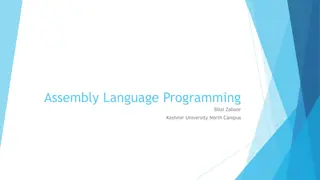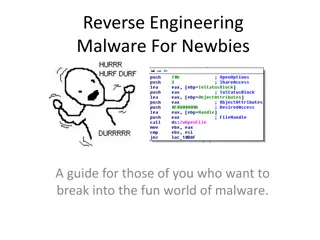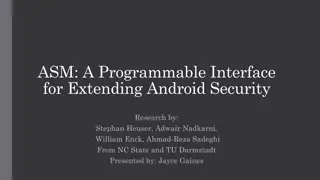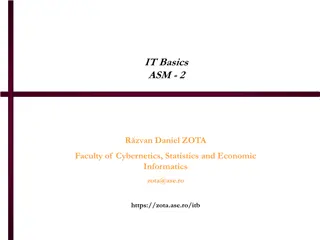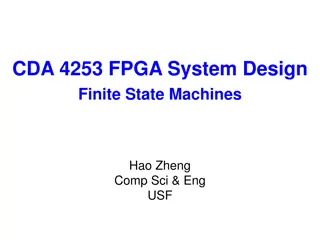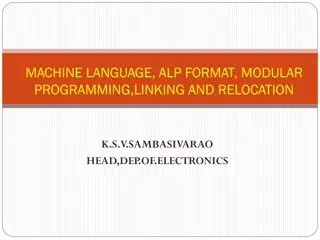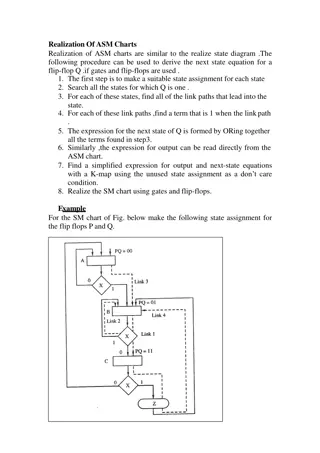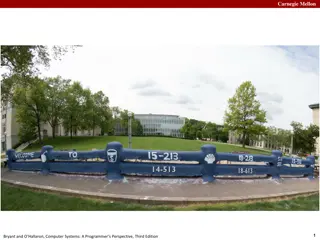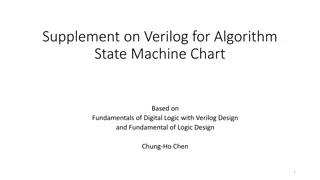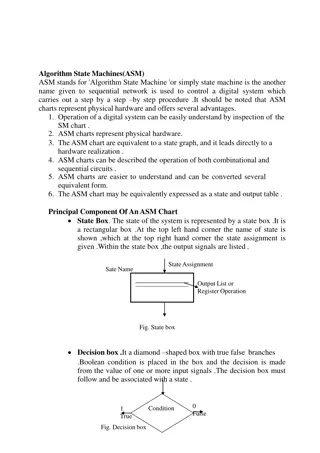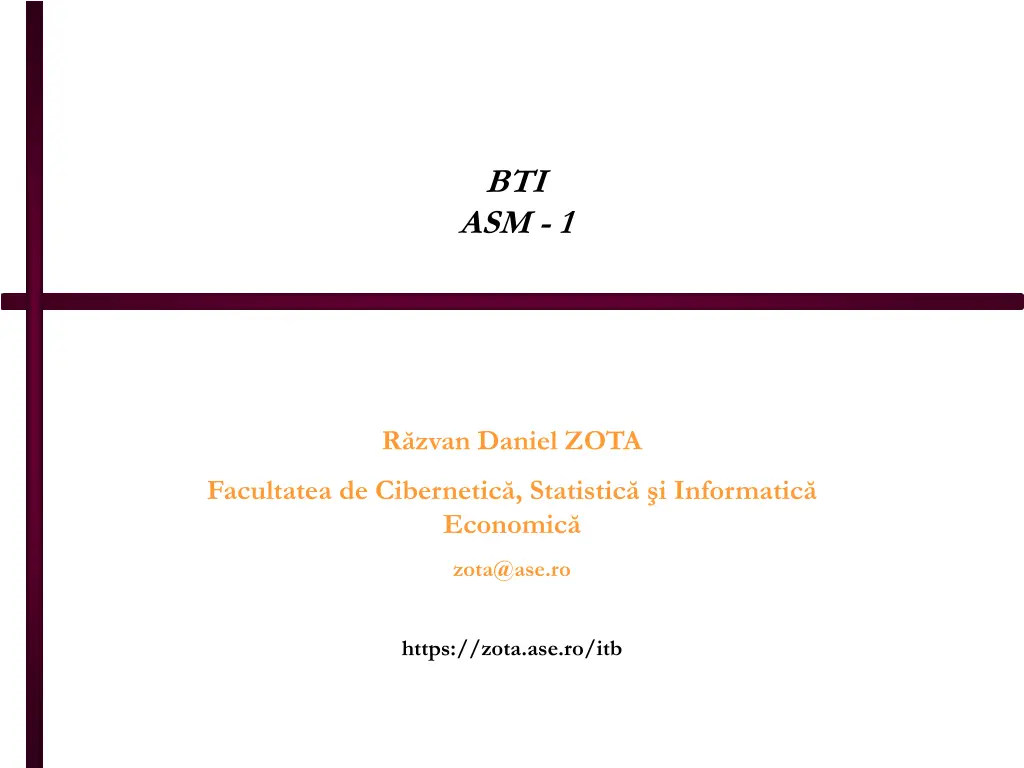
Logical Instructions and Memory Access in Assembly Language
Explore logical instructions, displacement, arithmetic operations, and memory access examples in assembly language. Learn about setting overflow and transport flags and understand different memory addressing modes using registers like SI, DI, BX, and BP. Dive into detailed explanations of stack operations and flag settings in 8086 and other x86 processors.
Download Presentation

Please find below an Image/Link to download the presentation.
The content on the website is provided AS IS for your information and personal use only. It may not be sold, licensed, or shared on other websites without obtaining consent from the author. If you encounter any issues during the download, it is possible that the publisher has removed the file from their server.
You are allowed to download the files provided on this website for personal or commercial use, subject to the condition that they are used lawfully. All files are the property of their respective owners.
The content on the website is provided AS IS for your information and personal use only. It may not be sold, licensed, or shared on other websites without obtaining consent from the author.
E N D
Presentation Transcript
BTI ASM - 1 R zvan Daniel ZOTA Facultatea de Cibernetic , Statistic iInformatic Economic zota@ase.ro https://zota.ase.ro/itb
Contents Logical instructions Displacement instructions Arithmetic instructions Overflow and transport Flags setting 2
Memory access examples mov si,var2 mov ax,[si] ; reading var2 from memory ; indirect reference mov bx,mesaj dec BYTE [bx+1] mov si, 1 inc [mesaj+SI] SEGMENT code var1 DW 01234h var2 DW 01234 var3 RESW ; defines a word with an unspecified ; value var4 DW 01BCDh mesaj DB Hello!' start: mov ax,cs ; sets the data segment mov ds,ax ; DS=CS ; any memory reference means that it is in the ;DS segment mov ax,[var2] ; AX <- [var2] ; == mov ax,[2] ; SI used as a pointer to var2 ; (equiv. C code: SI=&var2 ) ;defines a word with 1234h value ; defines a word with 1234 decimal value ; BX is a pointer to a string ; e' becomes d' ! ; SI is an index ; == inc [SI + 8] ; == inc [9] 3
Memory access examples (cont.) ;Memory may be addressed using 4 registers: ; SI -> Implies DS ; DI -> Implies DS ; BX -> Implies DS ; BP -> Implies SS ! ; Examples: mov ax,[bx] ;ax <- to a word from memory referred by BX mov al,[bx] ; al <- to a byte from memory referred by BX mov ax,[si] ; ax <- to a word referred by SI mov ah,[si] ; ah <- to a byte referred by SI mov cx,[di] ; cx <- to a word referred by DI mov ax,[bp] ; ax <- [SS:BP] stack operation ; BX+SI and BX+DI can also be used mov ax,[bx+si] mov ch,[bx+di] ; displacements on 8 or 16 bits mov ax,[23h] ; ax <- word to DS:0023 mov ah,[bx+5] ; ah <- byte to DS:(BX+5) mov ax,[bx+si+107] ; ax <- word to mov ax,[bx+di+47] ; DS:(BX+SI+107) ; ax <- word to ; DS:(BX+DI+47) ; Remember! The two operands of the MOV ;instruction cannot be both memory locations mov [bx],[si] mov [di],[si] ; Illegal instruction ; Illegal instruction ; Special case: stack operations! pop word [var] ; [var] <- SS:[SP] 4
FLAGS AC (Alignment check) (VM) Virtual mode (RF) Resume (NT) Nested task (IOPL) Input/output privilege level (O) Overflow (D) Direction (I) Interrupt (T) Trace (S) Sign (Z) Zero (A) Auxiliary Carry (P) Parity (C) Carry 8086, 8088, 80186 80386, 80486DX 80286 80486SX 5
Logical instructions They act bit-by-bit NOT: AND: OR: XOR: A =~A A &= B A |= B A ^= B With NOT exception, these instructions alter the flags as the following: Erase carry (C) Erase overflow (O) Set zero flag (Z) if the result is zero, or erase it contrary Copy the higher bit of the result in the sign flag (S) Set the parity bit (P) by the results parity The NOT instruction doesn t alter any flag 6
Logical instructions (cont.) TEST ( non-destructive AND) makes the logical AND of the operands and sets the flags, but not stores the result TEST AL,1 Sets the flags as the AND instruction but doesn t modify AL Modified flags: SF, ZF, PF, CF = 0, OF = 0, AF undefined AND and OR instructions are used for masking data A mask value is used to force some bits to be 0 or 1 in the case of another value A mask like this has effect on some bits while other bits are unchanged AND makes that the selected bits will be 0 AND CL, 0Fh OR makes that selected bits will be 1 OR CL, 0Fh 7
Shifting instructions (cont.) SHL/SAL (shift left/shift arithmetic left) Moves every bit of the operand with one position to the left specified by the count operand The free positions are set to zero to the LSB; the MSB is copied into the carry flag Represents a quick version of multiplying by 2 9
Examples ; let s see how can we multiply AX with 10 (1010 in binary) (we multiply by 2 and by 8, then we add ;the results) shl ax, 1 ; AX=AX * 2 mov bx, ax ; we save 2*AX shl ax, 2 ; 2*AX(original) * 4 = 8*AX (original) add ax, bx ; 2*AX + 8*AX = 10*AX ;let s see how can we multiply AX with 18 (10010 in binary) (we multiply by 2 and 16, the we add the ;results) shl ax, 1 ; AX=AX * 2 mov bx, ax ; we save 2*AX in BX shl ax, 3 ; 2*AX(original) by 8 = 16*AX (original) add ax, bx ; 2*AX + 16*AX = 18*AX 10
Homework Using the previous examples, compute AX*74 (you may use another additional register for storing a partial result, like CX) - you may use registers AX, BX, CX 11
Shifting instructions (cont.) SHR (shift right) All bits from the destination operand are moved to the right with one position Free positions are filled with the value of 0 (on MSB). LSB is copied into the carry flag Represents a quick mode of division by 2 (for unsigned numbers) 12
Shifting instructions (cont.) SAR (shift arithmetic right) All the bits of the destination operand are moved to the right with one bit replicating the MSB. LSB is copied to carry flag The main use is to divide a signed number to a power of two 13
Shifting instructions (cont.) RCL (rotate through carry left) Rotation of the bits to the left by using the carry flag MSB is copied to CF, all the bits are moved to the left with one position and the original CF is copied in the LSB of the operand ROL (rotate left) Rotation of the bits to the left with one position MSB of the operand is copied into LSB The bits 10-14 from AX are copied into the bits 0-4 ROL AX, 6 AND AX, 1fh 14
Shifting instructions (cont.) RCR (rotate through carry right) Rotation of the bits to the right using the carry flag The bit from CF is copied back to the MSB of the operand ROR (rotate right) Rotation of the bits to the right The LSB is copied into the MSB. 15
Shifting instructions Examples mov ax,3 mov bx,5 or ax,9 and ax,10101010b xor ax,0FFh neg ax not ax or ax,1 ; Initial values ; AX = 0000 0000 0000 0011 BX = 0000 0000 0000 0101 ; ax <- ax | 0000 1001 AX = 0000 0000 0000 1011 ; ax <- ax & 1010 1010 AX = 0000 0000 0000 1010 ; ax <- ax ^ 1111 1111 AX = 0000 0000 1111 0101 ; ax <- (-ax) ; ax <- (~ax) ; ax <- ax | 0000 0001 AX = 0000 0000 1111 0101 AX = 1111 1111 0000 1011 AX = 0000 0000 1111 0100 shl ax,1 shr ax,1 ror ax,1 rol ax,1 ; logical move to the left with one bit ; logical move to the right with one bit ; right rotation(LSB=MSB) ; left rotation(MSB=LSB) AX = 0000 0001 1110 1010 AX = 0000 0000 1111 0101 AX = 1000 0000 0111 1010 AX = 0000 0000 1111 0101 mov cl,3 shr ax,cl mov cl,3 shl bx,cl ; using CL for a 3 bit displacement ; dividing AX to 8 ; using CL for a 3 bit displacement ; multiplying BX by 8 CL = 0000 0011 AX = 0000 0000 0001 1110 CL = 0000 0011 BX = 0000 0000 0010 1000 16
Arithmetic instructions ADD (addition): A += B Adding registers: add ax, bx Effective addition: add dl, 33h Adding memory to register (data from memory added to AL): mov di, NUMB ;the address of NUMB mov al, 0 ;sum is erased add al, [di] ;adding [NUMB] add al, [di + 1] ;adding [NUMB + 1] 17
Arithmetic instructions(cont.) INC (increment addition): A++ mov di, NUMB ;the address of NUMB mov al, 0 ;sum erased add al, [di] ;adding [NUMB] inc di ;di = di + 1 add al, [di] ;adding[NUMB + 1] 18
Arithmetic instructions (cont.) ADC (addition with carry) - acting as a normal addition, excepting the carry flag bit which is added to the result Example: Adding two 32 bit numbers (BX AX) + (DX CX): add ax, cx adc bx, dx 19
Arithmetic instructions (cont.) SUB (subtraction): A -= B Subtraction using registers: sub cl, bl Effective subtraction: The result is -18 decimal (1110 1110) Flags: Z = 0 (non zero result) C = 1 (borrow) S = 1 (negative result) P = 1 (even parity) 0 = 0 (no overflow) mov ch, 22h sub ch, 34h 20
Arithmetic instructions (cont.) DEC (decrement subtraction): A-- , subtract the value of 1 from register/memory: DEC BH NOTE:DECdoesn t affect CF. SBB (subtract with borrow) acts like a normal subtraction, excepting that CF is subtracted from the result Example: Subtracting two 32 bit numbers (BX AX) - (SI DI): sub ax, di sbb bx, si 21
Overflow and carry Carry Indicate a carry (transport) in case of addition or a borrow in case of a subtraction CF: carry flag (unsigned) 1 => transport ; 0 => no transport ex: 36,864 (9000h) + 36,864 (9000h) = 73,728 (12000h) > 65,535 (FFFFh) {OV, CY} overflow, carry CF is set when the unsigned number is out of range (the arithmetic operation generated an overflow) Overflow It happens when two unsigned number are added or subtracted OF: overflow flag (signed) {1 = OV overflow, 0 = NV no overflow} ex: 20,480 (5000h) + 20,480 (5000h) = 40,960 (A000h) > 32,767 (7FFFh) {OV, NC} overflow, not carry OF is set when the result is out of range Example: FFFFh + FFFFh = FFFEh {(-1) + (-1)} = -2; NV, CY 22
Examples mov ax,0fffeh ; 65534 unsigned add ax,3 ; C = 1, O = 0 --- overflow unsigned condition mov ax,0FFFEh ; -2 signed add ax,3 ; C = 1, O = 0 --- Ok signed no. mov bx,07FFFh ; 32767 as signed no. add bx,1 ; C = 0, O = 1 --- Overflow signed condition mov bx,07FFFh ; 32767 unsigned add bx,1 ; C = 0, O = 1 --- Ok - unsigned mov ax,07h ; 7 signed/unsigned add ax,03h ; C = 0, O = 0 --- Ok no mater the sign 23
FLAGS setting FLAG Name Description Observations ZF Zero 1:ZR:Zero 0:NZ: Non-zero 1 means that the result is zero 0 otherwise CF Carry 1:CY 0:NC Mathematical unsigned operations and shifting (transport or borrow) OF Overflow 1:OV 0:NV Mathematical signed operations Negative numbers represented in two s complement SF Sign Flag 1:NG: - 0:PZ: + MSB of the result 24
Numerical comparisons CMP(compare) it compares 2 values: X and Y It is equivalent to a subtraction which modifies the flags Used for checking the contents of a register or memory location with another value It is used together with a conditional jump instruction CMP AL, 10h ;compares AL with 10h (AL it is not modified) JAE SUPER ;if AL is greater or equal with 10h it will jump to SUPER SUB (subtraction) it computes X - Y Saves the result in X and sets the flags
Flags settings CMP Op1, Op2 Unsigned Op Signed Op Z: equality/inequality Z: equality/inequality C: Op1 < Op2 (C=1) Op1 >= Op2 (C=0) C:f r semnifica ie S: no significance O: no significance S and O together If ((S=0) and (O=1)) or ((S=1) and (O=0)) then Op1 < Op2 If ((S=0) and (O=0)) or ((S=1) and (O=1)) then Op1 >= Op2
Comparing signed integers Let be the instruction: CMP AX,BX The Sign bit (S) will be set function of the result of AX-BX (if it has an 1 on the MSB) The Overflow flag (O) will be set if the result AX-BX produced a number outside the definition range (-32768 -> 32767 for 16 bits). Instructions JS (jump on sign) and JL (jump less than) JS checks the sign bit (S) for the last comparison/subtraction If S = = 1 then the jump is done JL checks (S XOR O) the last comparison (or subtraction)
Comparing signed integers(cont.) JL is true: S=1, O=0: (AX-BX) negative and (AX-BX) determines no overflow Example (8-bits): (-5) - (2) = (-7) The result (-7) has the sign bit set (-5) is less than (2)
Other comparisons When is used above/below and greater/less: unsigned comparison Above/Below signed comparison Greater/Less Meanings for jump instructions J => Jump N => Not A/B G/L => Above/Below Greater/Less E => Equal
Conditional jump instructions summary Instruction Description Conditions JA=JNBE JBE=JNA JAE=JNB=JNC JB=JNA=JC JE=JZ Jump if above Jump if not below or equal Jump if below or equal Jump if above or equal Jump if not below Jump if no carry Jump if below Jump if carry Jump if equal Jump if Zero Jump if not equal Jump if not zero Jump Sign (MSB=1) CF=0 & ZF=0 JNE=JNZ JS CF=1 | ZF=1 CF=0 CF=1 ZF=1 ZF=0 SF=1
Conditional jump instructions summary Instruction Description Conditions JNS Jump Not Sign (MSB=0) SF=0F JO Jump if overflow set OF=1 JNO Jump if no overflow OF=0 JG=JNLE Jump if greater Jump if not less or equal SF=OF & ZF=0 JGE=JNL Jump if greater or equal SF=OF Jump if not less JL=JNGE Jump if less SF OF Jump if not greater or equal JLE=JNG Jump if less or equal SF OF | ZF=1 Jump if not greater JCXZ Jump if register CX=zero CX=0



